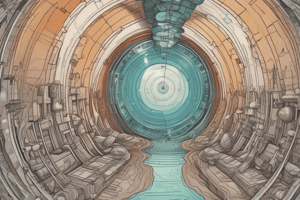Podcast
Questions and Answers
What defines space in an artwork?
What defines space in an artwork?
- The length of the lines used
- The number of primary colors present
- The use of complementary colours
- The visual area or environment created by the work of art (correct)
What are the primary colors?
What are the primary colors?
- Red, orange, green
- Green, purple, orange
- Red, yellow, blue (correct)
- Blue, orange, green
What do complementary colors do when placed next to each other?
What do complementary colors do when placed next to each other?
- Appear warmer
- Produce a strong contrast (correct)
- Create a calming effect
- Blend into each other
Which type of colors tend to make you think of warm things like sunlight and heat?
Which type of colors tend to make you think of warm things like sunlight and heat?
What is two-dimensional (2D) in reference to images or pictures?
What is two-dimensional (2D) in reference to images or pictures?
How do cool colors typically make one feel?
How do cool colors typically make one feel?
What is tessellation art?
What is tessellation art?
Which type of texture refers to how something feels?
Which type of texture refers to how something feels?
What is the main characteristic of a symmetrical drawing?
What is the main characteristic of a symmetrical drawing?
What is the focus of color theory?
What is the focus of color theory?
Which aspect defines observation drawing?
Which aspect defines observation drawing?
What does technique in art refer to?
What does technique in art refer to?
Flashcards are hidden until you start studying
Study Notes
Drawing and Observation
- Drawing by observation involves directly depicting subjects in front of you, without necessarily including every detail.
Tessellation
- Tessellation art involves covering a surface with geometric shapes that fit together like a jig-saw puzzle, leaving no gaps or overlaps.
Pattern
- A pattern is a regularity in the world or human-made design, where elements repeat in a predictable manner.
- Geometric patterns involve geometric shapes repeated like a wallpaper design.
Portraiture
- A portrait is a representation of a particular person, and a self-portrait is a portrait of the artist by themselves.
- Portraits can be vibrant, bright, and striking.
Symmetry
- Symmetry in art involves mirroring portions of an image across a symmetry line, with identical parts on either side.
Texture
- Texture refers to how something feels, and can be either actual or visual.
- There are two types of texture: actual texture and visual texture.
Guidelines and Colour
- Guidelines are general rules, principles, or pieces of advice to help with artistic creation.
- Colour theory is a practical guide for colour mixing and the visual effects of specific colour combinations.
- Colour terminology is based on the colour wheel.
Technique and Line
- Art techniques refer to the different methods and processes used to create art.
- A line is a mark made on a surface that joins different points, varying in length, width, direction, and shape.
Space and Dimension
- Space in art refers to the visual area or environment created by a work of art.
- Space can refer to the space within an object, between objects, or negative space.
- 2D refers to two-dimensional images or pictures that are flat rather than solid.
- 3D refers to three-dimensional objects with width, height, and depth.
Colour Theory
- Primary colours are red, yellow, and blue, which cannot be made by mixing other colours together.
- Secondary colours are colours made by mixing two primary colours, such as purple (blue and red), orange (yellow and red), and green (blue and yellow).
- Complementary colours are pairs of colours opposite each other on the colour wheel, creating the strongest contrast when placed together.
- Warm colours consist of orange, red, yellow, and combinations, evoking warmth and appearing to come closer.
- Cool colours consist of blue, green, and light purple, calming and soothing, and appearing to recede.
Studying That Suits You
Use AI to generate personalized quizzes and flashcards to suit your learning preferences.




